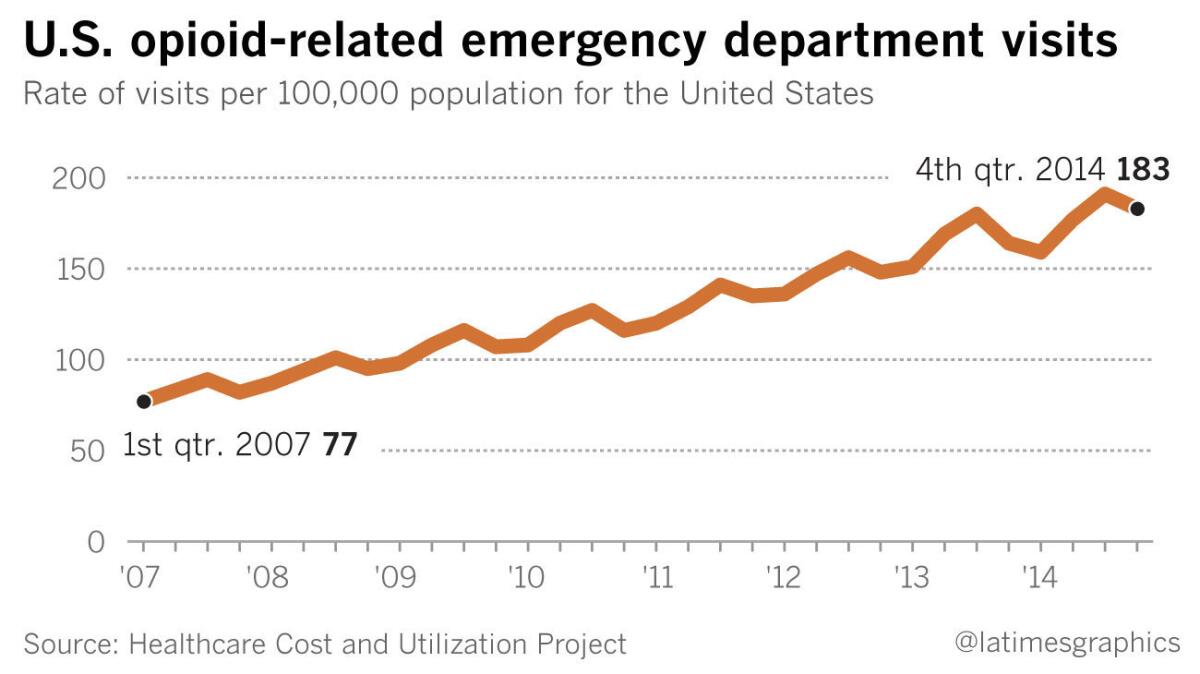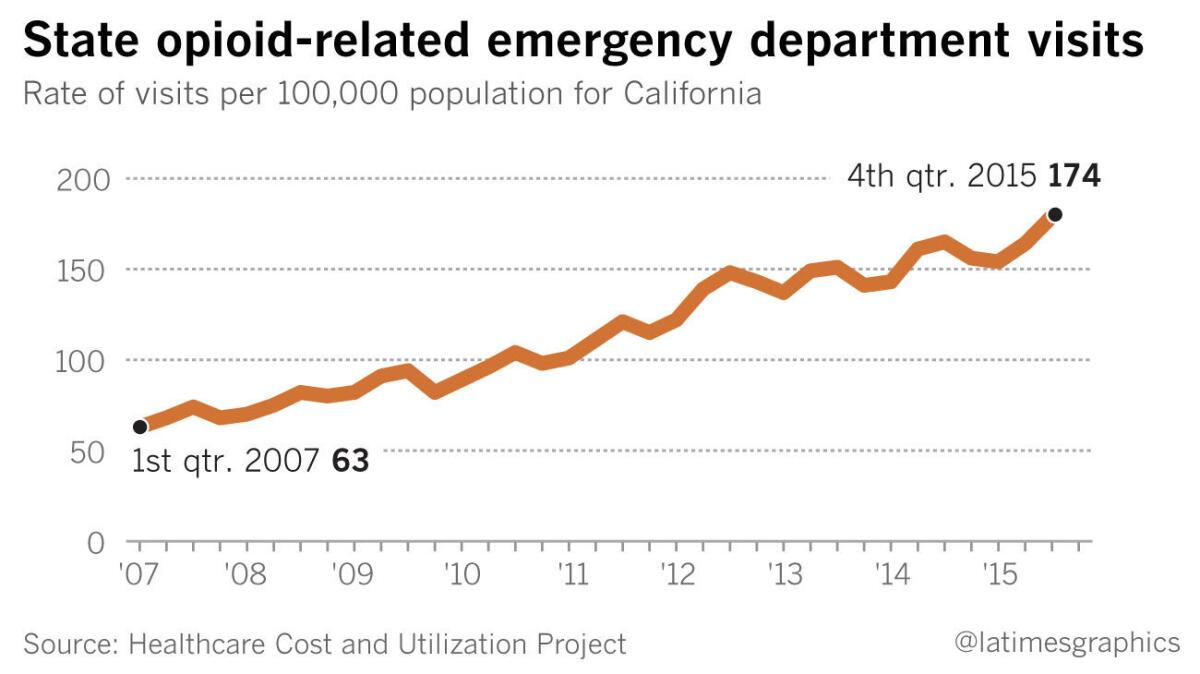Hospitalization rate for opioid abuse doubled in 10 years, report says

- Share via
The opioid epidemic continues to devastate Americans, and a new report shows that it has only gotten worse in recent years.
In 2014, abuse of prescription painkillers such as OxyContin and street drugs such as heroin sent users to hospitals at record rates. That is true in emergency rooms, and even more true in rooms for patients who have been admitted to the hospital.
The report, released Tuesday by the federal Agency for Healthcare Research and Quality, reveals that the rate of emergency room visits resulting from problems with opioids roughly doubled over a decade. Inpatient stays also grew, by 64%.
Here are some of the key findings:
Hospital admissions
• Patients who suffered overdoses or other problems with opioids were more likely to be admitted to a hospital than to be treated and released from the emergency room.
• For men, the rate of hospital admissions rose from 146 per 100,000 in 2005 to 225 per 100,000 in 2014.
• Women started out with a lower rate of opioid-related admissions, at 128 per 100,000. But over the ensuing decade, they just about caught up, ending at 224 admissions per 100,000.
• Though the nationwide hospital admissions rate was higher for men than for women in 2014, most states had higher admission rates for women than for men. The exceptions that year were California, Connecticut, the District of Columbia, Hawaii, Illinois, Louisiana, Massachusetts, Maryland, New Jersey, New York, Pennsylvania and Rhode Island. (Data were missing for Alabama, Alaska, Delaware, Idaho, Mississippi and New Hampshire.)
• Over the 10-year period, the rate of hospital admissions rose 55% for men and 75% for women.
Emergency room visits
• The nation’s emergency rooms also saw a dramatic increase in patients harmed by opioids.

• As with inpatient admissions, the rate of ER visits was higher for men than for women. But unlike inpatient admissions, the gap between the sexes did not close over the decade studied.
• In 2005, 100 out of every 100,000 men visited an emergency room for treatment related to opioids. By 2014, that rate rose 103%, to 203 per 100,000.
• Meanwhile, in 2005, 79 out of every 100,000 women visited an emergency room for opioid-related treatment. By 2014, that rate rose 95%, to 153 per 100,000.
• Among the 30 states that reported data on ER visits by gender, 23 had higher rates for men and seven had higher rates for women.
Age differences
• The age groups most likely to be admitted to a hospital were adults between the ages of 25 and 44, followed very closely by adults ages 45 to 64.
• By 2014, members of the younger group were being admitted at a rate of 321 per 100,000, a 55% increase over 2005. Meanwhile, in 2014, members of the older group were admitted at a rate of 317 per 100,000, up 64% over the same period.
• The group with the biggest increase in hospitalization rate was adults ages 65 and up. For these senior citizens, the admission rate rose from 134 per 100,000 in 2005 to 248 per 100,000 in 2014.
• When it came to opioid-related ER visits, there was a bigger gap among age groups. Adults ages 25-44 started out with the highest visitation rate (161 per 100,000 in 2005) and saw it more than double (to 336 per 100,000 in 2014).
• ER visits followed a similar trajectory for adults ages 45 to 64. In 2005, there were 90 visits per 100,000 people, and that rate more than doubled to 188 visits per 100,000 people by 2014.
• Children and young adults ages 1 to 24 were third-highest group for opioid-related ER visits, followed by senior citizens and infants under 1 year.
State differences
• The researchers ranked the states according to their 2014 rates of inpatient stays for each age group and both sexes. In this analysis, Massachusetts was the only state to rank in the top 25% in all of these categories.
• Connecticut, Maryland and Washington state ranked in the top 25 for both sexes and for three of the four age groups.
• The researchers did a similar analysis for rates of opioid-related emergency room visits in 2014. For ER visits, Maryland was the only state to rank in the top 25% in all age and sex categories.
• Massachusetts and Rhode Island also ranked in the top 25% for both sexes and for three of the four age groups.
California
• In California, the rate of hospital admissions due to opioids in 2014 was nearly the same for men (169 per 100,000) as for women (168 per 100,000).
• Senior citizens were admitted to hospitals at a rate of 303 per 100,000, while adults ages 45 to 64 were admitted at a rate of 286 per 100,000.

• In 2014, men went to ERs at higher rates (169 per 100,000) than women (144 per 100,000).
• Californians between the ages of 25 and 44 were the most likely to seek treatment in an ER in 2014 (229 per 100,000), followed by Californians ages 45 to 64 (215 per 100,000).
• For opioid-related hospital admissions in 2014, California ranked in the top 25% for senior citizens. It was in the bottom 25% for people ages 1 to 24, and for people ages 25-44.
• For opioid-related ER visits in 2014, the Golden State ranked in the top 25% for senior citizens.
Do you love science? I do! Follow me @DeborahNetburn and "like" Los Angeles Times Science & Health on Facebook.
MORE IN SCIENCE
How a 5-sentence letter helped fuel the opioid addiction crisis
Here's why experts say all kids ages 6 and up should be screened for obesity
Guns kill nearly 1,300 children in the U.S. each year and send thousands more to hospitals





